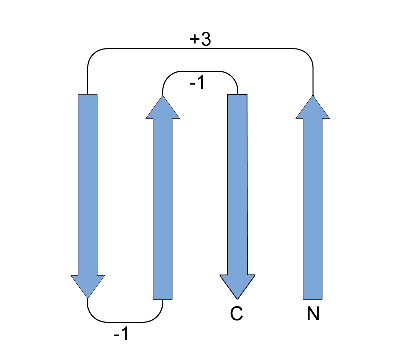CATH Documentation
Greek Key
This is a four-stranded beta sheet motif which is characterised by +3, -1, -1 connectivities in a two-dimensional schematic diagram of a protein structure, as shown here. The diagram on the left shows an N-type Greek key motif, whilst on the right is a C-type Greek key.
In three dimensions, the motif adopts a variety of structures. The Greek key can be considered as a chain folded in half, then twisted around to form a pattern like that commonly seen on Greek vases. Greek keys can occur with all four participating strands in the same beta sheet, or in two different sheets. A four-stranded Greek key motif can be defined by the following rules: four sequential strands must be either in one, or at most, in two different beta sheets; within any one sheet the participating strands must be hydrogen bonded together; hydrogen-bonded strands within one sheet must be antiparallel; and strands 1 and 4 must be hydrogen bonded.
The example structure shown here is the beta/gamma crystallin domain (CATH domain ID 1prrA01).
References
Hutchinson EG, Thornton JM
Protein Eng6p233-45(1993 Apr)


